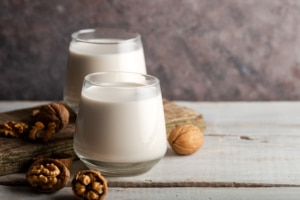You’ve tried almond milk, coconut milk, and cashew milk. Now, give walnut milk a try to reap the many health benefits it provides, not to mention its delightful flavor. Glenda’s Farmhouse walnuts deserve a place of honor in your kitchen, along with our almonds, cashews, pecans, and other wholesome ingredients.
Walnut Milk Nutrition Facts

- 219 calories
- 8.6 g carbohydrates
- 2 g dietary fiber
- 5.2 g sugars
- 20 g fat
- 1.9 g saturated fat
- 1.9 g polyunsaturated fat
- 2.7 g monounsaturated fat
- 0 g trans fat
- 4.6 g protein
- 43.2 mg sodium
- 136.6 mg potassium
- 0 mg cholesterol
Advantages of Consuming Walnut Milk
As the base ingredient of walnut milk, the nutritiousness of walnuts flows into the walnut milk you enjoy. Unsweetened walnut milk has few carbs while it’s high in fat (the good kind) and protein.
- A wealth of antioxidants in walnuts offers anti-inflammatory properties and protection from oxidation-related damage.
- The wealth of essential fatty acids (AKA omega 3s) reduces your risk of heart disease and cognitive decline.
- Significant amounts of fiber within walnuts aid in weight and blood sugar management.
- High amounts of vitamin E protect from Alzheimer’s and other cognitive impairments.
The key to keeping walnut milk healthy is how it’s made. If you buy commercial walnut milk, choose a product that doesn’t water down the nutrition the walnuts provide.
Make Your Own Walnut Milk with Two Ingredients:
- Glenda’s Farmhouse walnuts
- Filtered water
Use a ratio of 1 part walnuts for every 4 parts water. For example, use 1 cup of walnuts and 4 cups of filtered water.
You’ll also need a blender and a filtering device (nut milk bag, coffee filter, cheesecloth, etc.).
Phase One – Soak the Walnuts
- With the walnuts in a large bowl, add water to cover the walnuts and then add ½ tsp of salt. Allow them to soak between 6-12 hours.
- Drain the walnuts.
- Rinse.
Phase Two – Blend
- Put the soaked, drained, and rinsed walnuts into a blender.
- Blend to a just rough consistency.
- Add the filtered water.
- Blend for an additional two minutes, stopping when the result is creamy with a milk-like texture.
Phase Three – Strain
- With the filtering tool of your choice – nut milk bag, coffee filter, etc. – and a bowl, pour the walnut milk to strain. Walnut milk won’t have much pulp.
Phase Four – Enjoy or Store
Phase Five (optional) – Flavor and Add-Ins
- A pinch of salt
- Sweeteners (dates, monk fruit, honey, etc.)
- Vanilla extract (1 tsp)
- 2 TBSP Cocoa powder, sweetener, and a pinch of salt
- 2-3 TBSP maple syrup, a pinch of salt, and vanilla
- ¼ – ½ tsp ground cinnamon and sweetener
Storing Walnut Milk
Use an airtight container to store walnut milk in the refrigerator for 3-5 days. Don’t be worried if you notice the walnut milk separates; it’s completely normal. Just give it a shake before use. The nose will know if it’s turned.
Ways to Use Walnut Milk:
- Cereal
- Granola
- Oatmeal
- Overnight oats
- Smoothies
- Smoothie bowls
- Ice cream
- Milkshakes
- Custom flavored or as it is
Enjoy the benefits of walnut milk, easily and affordably, with quality ingredients from Glenda’s Farmhouse. Our mission is to promote healthy eating, wholesome foods, and sustainable farming practices. We offer walnuts, almonds, hazelnuts, pecans, cashews, sea salts, and more. Bring questions to our team by clicking here.



